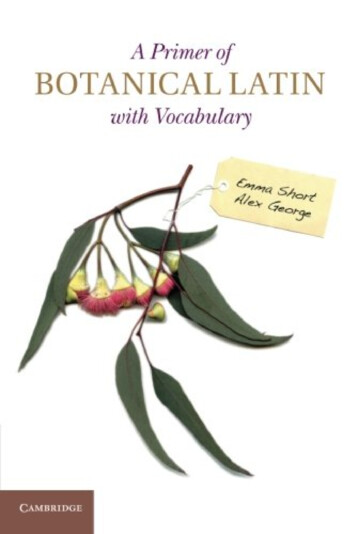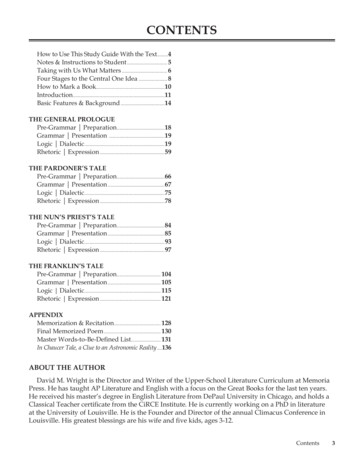
Transcription
Comp. by: Vpugazhenthi Stage: Proof Chapter No.: FMDate:22/10/12 Time:18:08:10 Page Number: 1Title Name: SHORTandGEORGEA Primer ofBotanical Latin withVocabularyLatin is one of two acceptable languages for describing new plants, andtaxonomists must be able to translate earlier texts in Latin. Providing asimple explanation of Latin grammar along with an in-depth vocabulary, this is an indispensable guide for systematic botanists worldwide.All relevant parts of speech are discussed, with accompanyingexamples, as well as worked exercises for translating diagnoses anddescriptions to and from Latin. Guidelines for forming specific epithetsare also included. The authors cross-reference their grammar to Stearn’sBotanical Latin and to articles in the International Code of Nomenclature for Algae, Fungi and Plants. The comprehensive vocabulary isenhanced with terms from recent glossaries for non-flowering plants –lichens, mosses, algae, fungi and ferns – making this an ideal resourcefor anyone looking to hone their understanding of Latin grammar andto translate botanical texts from the past 300 years.Emma Short worked for 5 years at the Royal Botanic Gardens, Kew, UK,on the Index Kewensis database, before co-editing the Authors of PlantNames database with R. K. Brummitt. She has regularly checked Latinfor Australian Systematic Botany, and has recently taught courses inBotanical Latin.Alex George is an Adjunct Associate Professor at the School ofBiological Sciences and Biotechnology, Murdoch University, Perth. Hewas a botanist with the Western Australian Herbarium for 21 years, thenEditor of the Flora of Australia for 12 years. He studied Latin to Tertiarylevel and has used it in describing some 400 new taxa, translating forothers and editing.
Comp. by: Vpugazhenthi Stage: Proof Chapter No.: FMDate:22/10/12 Time:18:08:10 Page Number: 2Title Name: SHORTandGEORGE
Comp. by: Vpugazhenthi Stage: Proof Chapter No.: FMDate:22/10/12 Time:18:08:10 Page Number: 3Title Name: SHORTandGEORGEA Primer ofBotanical Latin withVocabularyEmma ShortDarwin, Northern Territory, AustraliaAlex George (AM)Murdoch University, Perth, Western Australia
Comp. by: Vpugazhenthi Stage: Proof Chapter No.: FMDate:22/10/12 Time:18:08:11 Page Number: 4Title Name: SHORTandGEORGEcambridge university pressCambridge, New York, Melbourne, Madrid, Cape Town,Singapore, São Paulo, Delhi, Mexico CityCambridge University PressThe Edinburgh Building, Cambridge CB2 8RU, UKPublished in the United States of America byCambridge University Press, New Yorkwww.cambridge.orgInformation on this title: www.cambridge.org/9781107693753 Cambridge University Press 2013This publication is in copyright. Subject to statutory exceptionand to the provisions of relevant collective licensing agreements,no reproduction of any part may take place withoutthe written permission of Cambridge University Press.First published 2013Printed and bound in the United Kingdom by the MPG Books GroupA catalogue record for this publication is available from the British LibraryLibrary of Congress Cataloguing in Publication dataISBN 978-1-107-69375-3 PaperbackCambridge University Press has no responsibility for the persistence oraccuracy of URLs for external or third-party internet websites referred toin this publication, and does not guarantee that any content on suchwebsites is, or will remain, accurate or appropriate.
Comp. by: Vpugazhenthi Stage: Proof Chapter No.: FMDate:22/10/12 Time:18:08:11 Page Number: 5Title Name: SHORTandGEORGETo my parents Tudor and Enid Powell, who encouraged the Latin, andEdward Mason who taught the botany: multae gratiae. (ES)To ‘Foureyes’, my Latin teacher at school (also known as EdwardJ. Price): gratias reddo; semper meminero. May the Roman gods besmiling upon you. (AG)
Comp. by: Vpugazhenthi Stage: Proof Chapter No.: FMDate:22/10/12 Time:18:08:11 Page Number: 6Title Name: SHORTandGEORGE
Comp. by: Vpugazhenthi Stage: Proof Chapter No.: FMDate:22/10/12 Time:18:08:12 Page Number: 7Title Name: SHORTandGEORGEContentsPrefacepage ixAcknowledgmentsxIntroductionxiPart I Grammar1 The noun32 The adjective and the participle213 The adverb344 The preposition365 The conjunction386 The pronoun407 The verb478 Numerals, measurements509 Prefixes and suffixes5710 Miscellany59Part II Exercises in translation11 Exercises6712 Answers to the exercises78Part III Translating13 Translating into Latin14 Translating from Latin into English91103Part IV VocabularyReferences and further reading335Index338
Comp. by: Vpugazhenthi Stage: Proof Chapter No.: FMDate:22/10/12 Time:18:08:12 Page Number: 8Title Name: SHORTandGEORGE
Comp. by: Vpugazhenthi Stage: Proof Chapter No.: FMDate:22/10/12 Time:18:08:13 Page Number: 9Title Name: SHORTandGEORGEPrefaceThis primer is based on short courses in botanical Latin run in Australia at theNorthern Territory Herbarium, Darwin, and the Western Australian Herbarium, Perth. We presented these independently and, on discovering that wehad similar approaches, decided to combine them as a book.Between 1 January 1935 and 31 December 2011 it was mandatory that newplant names be accompanied by a diagnosis or description in Latin. For nonfossil algae the period was 1 January 1958 to 31 December 2011, while forfossil plants published on or after 1 January 1996 either Latin or English couldbe used. From 1 January 2012, descriptions of all of these will be permissible ineither Latin or English. Besides this, there will always remain a need fortranslating from Latin in order to understand the many botanical texts in thislanguage.William Stearn’s wonderful Botanical Latin appeared in 1966 and has gonethrough many new impressions and editions, as well as a Chinese translation.It provides almost all one could require for translating to and from Latin, but aprimer (in the sense of works such as Kennedy’s Shorter Latin Primer,providing the basic needs) may be useful for those who need to translate themore straightforward diagnoses and short descriptions now widely used whendescribing new taxa. Besides its concise approach, our work also differs fromStearn’s in including many more terms (especially from cryptogamic groups)in the vocabulary, while excluding many terms not used in descriptions.
Comp. by: Vpugazhenthi Stage: Proof Chapter No.: FMDate:22/10/12 Time:18:08:14 Page Number: 10Title Name: SHORTandGEORGEAcknowledgementsOur gratitude goes to those who read and commented upon our manuscript,especially to Vivienne Kent, who worked her way through the book and taughtherself botanical Latin in the process, to Katherine Challis, who checked forinconsistencies, Matthew Barrett who suggested some fruitful glossaries offungi, and William Powell, who gave advice. A number of colleagues assistedwith advice on terms to be included.To those who attended our courses, which provided the inspiration for AlexGeorge’s course notes, and Emma Short’s Aide-mémoire, and who attendedour classes faithfully in spite of the seemingly indigestible nature of Latingrammar, many thanks.We are grateful to the Northern Territory Herbarium for providing deskspace for our working bees (Apis mellifera).
Comp. by: Vpugazhenthi Stage: Proof Chapter No.: FMDate:22/10/12 Time:18:08:14 Page Number: 11Title Name: SHORTandGEORGEIntroductionClassical Latin – that used by the Romans – is fairly different in many respectsfrom modern Latin, and from scientific Latin, in particular. In scientific Latinthe basic grammar and syntax remain but much of the vocabulary is different –understandably, as many terms were unknown to the Romans. In particular, inbotanical Latin we tend to omit most verbs, making a kind of telegraphic style,so avoiding one of the more difficult parts of the language.This primer aims to teach you the very basics of botanical Latin, so thatwhen the time comes for you to compose your own first description ordiagnosis, starting off will not be the drama you feared, as at least you willunderstand the basic workings of the language and the methods used intranslation. Likewise, with this primer as a guide, you should be able totranslate most botanical texts written in Latin. Bear in mind that earlybotanical Latin – say, until 1850 or later – is more akin to classical Latin,and so texts from that time will require wider knowledge of grammar, orassistance from a Latin scholar.In many examples in this book, we give the literal translation into English aswell as the colloquial so that the differences between the two languages can bedemonstrated. This means that the English may sometimes appear slightlyunusual or stilted, as the word order will be a bit eccentric.Whereas classical Latin is a dead language, botanical Latin is very muchalive and kicking and has evolved to include a goodly smattering of Greekwords – which are then ‘forced’ into behaving as Latin words instead of beingdeclined in a Greek way, which can cause wincing, groans and horror in theClassical establishment. The classical Latin alphabet comprised 23 letters, thatis, the modern Latin alphabet minus ‘j’, ‘u’ and ‘w’. The letter ‘k’ was rarelyused and ‘y’ appeared in few words, mainly of Greek origin. The letter ‘u’,which was pronounced as a vowel, was represented by ‘v’ and came into usewhen lower-case letters were developed much later. (Did you know that lowercase letters didn’t exist when letters were first invented?) In botanical Latin weuse the whole English alphabet. The letter ‘j’ represents the consonantal orclassical ‘i’ and is pronounced like the ‘y’ in ‘yes’.Latin is a highly inflected language which means that not only do wordschange according to whether they are singular or plural, e.g. ‘flower’ and
Comp. by: Vpugazhenthi Stage: Proof Chapter No.: FMDate:22/10/12 Time:18:08:15 Page Number: 12xiiTitle Name: SHORTandGEORGEIntroduction‘flowers’ in English, but also the relationship of the word to the rest of thesentence, whether it is the subject or object, whether it is governed by apreposition, and so on, can be deduced from the ending of the word. In otherwords, the subject and object of a verb are not denoted by their positionsrelative to the verb within the sentence (in English, sentence construction isbased upon subject, verb and object in that order), but the sense is incorporated into the nouns themselves, e.g.The boy picked the fruitPuer fructum carpit or fructum carpit puer or fructum puer carpitIn each of the three Latin examples above, exactly the same words withtherefore exactly the same meanings are used, although they are written inthree different orders. Grammatically, the sentences are still the same,although the emphasis has been changed. If this is tried in English, however,the sentence is rapidly reduced to nonsense (unless the author is writingRomantic poetry: Alexander Pope ‘Pleasures the sex, as children birds, pursue,Still out of reach, yet never out of view ’) (Epistle II. To a Lady. Of theCharacters of Women 1743).A few curiosities about Latin: there is no article (the, a, an), and there are no words for ‘yes’ and ‘no’ – instead you make a statement in thepositive or negative.Why do botanists need Latin?A good explanation was given by Lack (2011), although it was published justbefore the XVI International Botanical Congress in Melbourne and thus withthe future of botanical Latin uncertain. We set out the main reasons thus:1. It is one of two languages allowed for describing new taxa under theInternational Code of Nomenclature for algae, fungi and plants (MelbourneCode, in preparation). See below for requirements from 1935 to 2011.2. We need it in order to understand the many texts written in Latin,especially those without a translation into any other language.3. Latin can help us to know plants if an epithet is descriptive and hence toapply that name; e.g. if our plant has white flowers then we can bereasonably sure that it is not a species with the epithet coccineus (scarlet).4. It’s a great language and can help in understanding both English grammarand the origin of many words, not only English but also of other Romancelanguages.
Comp. by: Vpugazhenthi Stage: Proof Chapter No.: FMDate:22/10/12 Time:18:08:15 Page Number: 13Title Name: SHORTandGEORGEWhy do botanists need Latin?5. It now belongs to no country, so is impartial, and it enables a readeranywhere to understand a description or diagnosis, even if the accompanying text is in a language that they cannot read.Although it is no longer mandatory to provide a Latin description or diagnosis, it is important to understand the requirements that were in force previously. The International Code of Botanical Nomenclature (Vienna Code,McNeill et al., 2006) refers to Latin in four Articles – 23, 32, 36 and 60. Ofthese the most important is Article 36.Article 36.1 On or after 1 January 1935 a name of a new taxon (algal andall fossil taxa excepted) must, in order to be validly published, beaccompanied by a Latin description or diagnosis or by a referenceto a previously and effectively published Latin description ordiagnosis.Article 36.2 In order to be validly published, a name of a new taxon ofnon-fossil algae published on or after 1 January 1958 must be accompanied by a Latin description or diagnosis or by a reference to apreviously and effectively published Latin description or diagnosis.Article 36.3 In order to be validly published, a name of a new taxon offossil plants published on or after 1 January 1996 must be accompanied by a Latin or English description or diagnosis or by areference to a previously and effectively published Latin or Englishdescription or diagnosis.Recommendation 36A.1 Authors publishing names of new taxa of non-fossilplants should give or cite a full description in Latin in addition to thediagnosis.These rules ceased to be effective on 1 January 2012 but still apply to namespublished between the dates cited and 31 December 2011. At the Nomenclature Sessions of the XVIII International Botanical Congress held in Melbourne,Aus
primer (in the sense of works such as Kennedy’s Shorter Latin Primer, providing the basic needs) may be useful for those who need to translate the more straightforward diagnoses and short descriptions now widely used when describing new taxa. Besides its concise approach, our work also differs from Stearn’s in including many more terms (especially from cryptogamic groups) in the .











